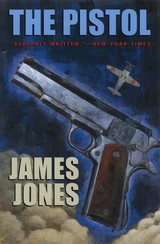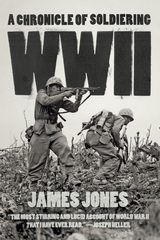3 books about Jones, James

The Pistol
James Jones
University of Chicago Press, 2003
As bombs begin to fall on Pearl Harbor, nineteen-year-old PFC Richard Mask is wearing a pistol, a .45 caliber automatic that makes him feel connected to the army of the Wild West and Custer's Cavalry. In the chaos of his first days and weeks of the war, as Mask and his company move from Schofield Barracks to the beaches of Oahu, then to a remote mountain pass, a struggle over the pistol dominates this novella's action, providing the pathos and savagery of the story.
[more]

When Cowboys Come Home
Veterans, Authenticity, and Manhood in Post–World War II America
Aaron George
Rutgers University Press, 2024
When Cowboys Come Home: Veterans, Authenticity, and Manhood in Post–World War II America is a cultural and intellectual history of the 1950s that argues that World War II led to a breakdown of traditional markers of manhood and opened space for veterans to reimagine what masculinity could mean. One particularly important strand of thought, which influenced later anxieties over “other-direction” and “conformity,” argued that masculinity was not defined by traits like bravery, stoicism, and competitiveness but instead by authenticity, shared camaraderie, and emotional honesty. To elucidate this challenge to traditional “frontiersman” masculinity, Aaron George presents three intellectual biographies of important veterans who became writers after the war: James Jones, the writer of the monumentally important war novel From Here to Eternity; Stewart Stern, one of the most important screenwriters of the fifties and sixties, including for Rebel without a Cause; and Edward Field, a bohemian poet who used poetry to explore his love for other men. Through their lives, George shows how wartime disabused men of the notion that war was inherently a brave or heroic enterprise and how the alienation they felt upon their return led them to value the authentic connections they made with other men during the war.
[more]

WWII
A Chronicle of Soldiering
James Jones
University of Chicago Press, 1975
In 1975, James Jones—the American author whose novels From Here to Eternity and The Thin Red Line had made him the preeminent voice of the enlisted man in World War II—was chosen to write the text for an oversized coffee table book edited by former Yank magazine art director Art Weithas and featuring visual art from World War II. The book was a best seller, praised for both its images and for Jones’s text, but in subsequent decades the artwork made it impossible for the book to be reproduced in its original form, and it fell out of print and was forgotten. This edition of WWII makes available for the first time in more than twenty years Jones’s stunning text, his only extended nonfiction writing on the war that defined his generation.
Moving chronologically and thematically through the complex history of the conflict, Jones interweaves his own vivid memories of soldiering in the Pacific—from the look on a Japanese fighter pilot’s face as he bombed Pearl Harbor, so close that Jones could see him smile and wave, to hitting the beach under fire in Guadalcanal—while always returning to resounding larger themes. Much of WWII can be read as a tribute to the commitment of American soldiers, but Jones also pulls no punches, bluntly chronicling resentment at the privilege of the officers, questionable strategic choices, wartime suffering, disorganization, the needless loss of life, and the brutal realization that a single soldier is ultimately nothing but a replaceable cog in a heartless machine. As the generation that fought and won World War II leaves the stage, James Jones’s book reminds us of what they accomplished—and what they sacrificed to do so.
Moving chronologically and thematically through the complex history of the conflict, Jones interweaves his own vivid memories of soldiering in the Pacific—from the look on a Japanese fighter pilot’s face as he bombed Pearl Harbor, so close that Jones could see him smile and wave, to hitting the beach under fire in Guadalcanal—while always returning to resounding larger themes. Much of WWII can be read as a tribute to the commitment of American soldiers, but Jones also pulls no punches, bluntly chronicling resentment at the privilege of the officers, questionable strategic choices, wartime suffering, disorganization, the needless loss of life, and the brutal realization that a single soldier is ultimately nothing but a replaceable cog in a heartless machine. As the generation that fought and won World War II leaves the stage, James Jones’s book reminds us of what they accomplished—and what they sacrificed to do so.
[more]
READERS
Browse our collection.
PUBLISHERS
See BiblioVault's publisher services.
STUDENT SERVICES
Files for college accessibility offices.
UChicago Accessibility Resources
home | accessibility | search | about | contact us
BiblioVault ® 2001 - 2024
The University of Chicago Press









